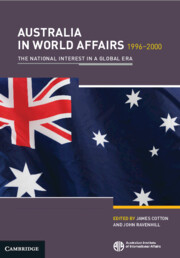146 results
Stunting and inequality in Sri Lanka compared to other Low- and middle-income South Asian countries
-
- Journal:
- Public Health Nutrition / Accepted manuscript
- Published online by Cambridge University Press:
- 19 March 2025, pp. 1-16
-
- Article
-
- You have access
- Open access
- Export citation
The moment of marriage: Towards a history of temporality in South Asia, circa 1650–1850
-
- Journal:
- Modern Asian Studies , First View
- Published online by Cambridge University Press:
- 10 March 2025, pp. 1-27
-
- Article
- Export citation
Introduction
-
- Book:
- Mobile Manuscripts
- Published online:
- 30 January 2025
- Print publication:
- 06 February 2025, pp 1-38
-
- Chapter
- Export citation
Conclusion
-
- Book:
- Mobile Manuscripts
- Published online:
- 30 January 2025
- Print publication:
- 06 February 2025, pp 260-266
-
- Chapter
- Export citation
11 - A Fractured Dream of the Decolonisation and De-eliticisation of English within EMI Programmes in South Asia
- from Part III - The Politics of English in Education
-
-
- Book:
- Critical English Medium Instruction in Higher Education
- Published online:
- 31 January 2025
- Print publication:
- 06 February 2025, pp 183-199
-
- Chapter
- Export citation

The Origins of Agriculture in the Bronze Age Indus Civilization
-
- Published online:
- 13 December 2024
- Print publication:
- 02 January 2025
Taphonomy and labour at the Indus Valley site of Harappa (3700–1300 BC)
-
- Article
-
- You have access
- Open access
- HTML
- Export citation
Corrupt Traditions and Traditions of Corruption: Caste, Colonialism, and Corruption in Late Nineteenth-Century India
-
- Journal:
- Itinerario / Volume 48 / Issue 2 / August 2024
- Published online by Cambridge University Press:
- 29 November 2024, pp. 152-168
-
- Article
-
- You have access
- Open access
- HTML
- Export citation
The People’s Court: Dissonant Institutionalization and Judicial Populism in Pakistan
-
- Journal:
- Law & Social Inquiry , First View
- Published online by Cambridge University Press:
- 29 November 2024, pp. 1-32
-
- Article
-
- You have access
- Open access
- HTML
- Export citation
Made in South Asia: Centering Labor in Textile and Garment Manufacturing Work, 1970s to 2020s
-
- Journal:
- International Labor and Working-Class History , First View
- Published online by Cambridge University Press:
- 28 October 2024, pp. 1-8
-
- Article
-
- You have access
- Open access
- HTML
- Export citation
Ibn Khaldūn's reception in colonial South Asia
-
- Journal:
- Journal of the Royal Asiatic Society / Volume 34 / Issue 4 / October 2024
- Published online by Cambridge University Press:
- 19 September 2024, pp. 729-743
- Print publication:
- October 2024
-
- Article
-
- You have access
- Open access
- HTML
- Export citation
1 - Parties and Political Violence
-
- Book:
- Playing with Fire
- Published online:
- 25 October 2024
- Print publication:
- 27 June 2024, pp 1-29
-
- Chapter
- Export citation
3 - The Development of Divergent Parties and Party Systems in Kenya and India
-
- Book:
- Playing with Fire
- Published online:
- 25 October 2024
- Print publication:
- 27 June 2024, pp 51-75
-
- Chapter
- Export citation
6 - Party Stabilization, Declining Riot Violence, and New Modalities of Political Conflict in India
-
- Book:
- Playing with Fire
- Published online:
- 25 October 2024
- Print publication:
- 27 June 2024, pp 126-141
-
- Chapter
- Export citation
7 - Party Politics and Subnational Trajectories of Riot Violence in India’s Hyderabad and Meerut Cities
-
- Book:
- Playing with Fire
- Published online:
- 25 October 2024
- Print publication:
- 27 June 2024, pp 142-172
-
- Chapter
- Export citation
6 - Marching into the Great Wall of State
- from Part III - The Boundaries of Decolonization
-
- Book:
- States-in-Waiting
- Published online:
- 09 May 2024
- Print publication:
- 16 May 2024, pp 175-202
-
- Chapter
-
- You have access
- Open access
- HTML
- Export citation

Australia in World Affairs 1996–2000
- The National Interest in a Global Era
-
- Published online:
- 04 May 2024
4 - Australia’s Relations with South Asia
- from Part II - Relationships
-
-
- Book:
- Australia in World Affairs 1996–2000
- Published online:
- 04 May 2024, pp 39-51
-
- Chapter
- Export citation
8 - Australia’s Strategic and Commercial Engagement with South Asia under Kevin Rudd: The Paradoxes
-
-
- Book:
- Australia in World Affairs 2006–2010
- Published online:
- 04 May 2024, pp 112-126
-
- Chapter
- Export citation
An exploratory investigation of functional variation in South Asian online Englishes
-
- Journal:
- English Language & Linguistics / Volume 28 / Issue 2 / June 2024
- Published online by Cambridge University Press:
- 01 April 2024, pp. 371-400
-
- Article
-
- You have access
- Open access
- HTML
- Export citation


